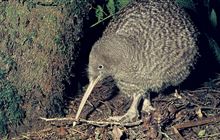Kiwi heard at Mt Te Kinga
Archived content: This media release was accurate on the date of publication.
Introduction
DOC is advancing its knowledge of the distribution of roroa/great spotted kiwi with the use of technology that cuts down on time listening to forest sound recordings.Date: 25 February 2019
The work has yielded the discovery of a female roroa living on Mt Te Kinga on the north shores of Lake Brunner on the West Coast of the South Island.
Darrell Haworth, Senior Biodiversity Supervisor for DOC in the Mawhera/Greymouth district, says, “We are aware of kiwi being in this area as late as 1980 but this had not been confirmed in recent times. We’ll survey this area more thoroughly to find out whether there are more kiwi present.
“The confirmation of kiwi in this area is exciting and also a reminder to heed “no dog” signs in this area – dogs are a major threat to kiwi.”
The technology that “heard” the kiwi uses “listening” devices that gather raw data in areas where birds are believed to be. This data is then screened through a software programme which cuts out background noise – meaning it’s much faster for people to listen to the recordings.
Darrell says the technology makes it far more economical to conduct kiwi surveys.
“Current understanding suggests the sub-alpine zones of north west Nelson, the Paparoa Range, and Arthur’s Pass are home to the roroa but as we are able to conduct more surveys, we hope to find roroa in even more places”.
“Because these kiwi can live at higher altitudes, where there are fewer predators, they have declined at a slower rate than kiwi at lower altitudes but we know that originally they were found at much lower altitudes and may be still present there in low numbers.”
Contact
For media enquiries contact:
Email: media@doc.govt.nz

